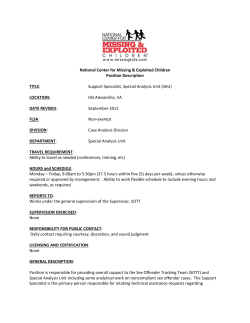
Restitution Judgement Order - Vermont Center for Crime Victim
Restitution Judgment Order An excellent tool for holding the offender accountable. Samples Available Greater Community and the Restitution Unit as Partners Victim Victim's Name: The victim incurred an uninsured material loss in the total amount of $ Victim Information The victim is listed in the center of the RJO. If the victim is a business it should be listed as such. Offender •The offender is also known as the defendant. •This information is used to ensure proper identification and to establish communication. •Monthly communication is required until the restitution is paid in full. Working together to make amends The RJO is a Court Order •The county and docket no. identify the Superior Court Criminal Division from which the restitution judgment order was issued. Title 13 V.S.A. § 7043 Restitution (unofficial copy handouts available) Or visit http://www.leg.state.vt.us on the left hand side of the webpage you’ll find the Vermont Statues Online. The Judge’s Signature The judge’s signature is the only signature required. Offender’s Signature It is preferable to have the offender’s signature which indicates that the offender is aware that restitution is owed, however, only the judge’s signature is required. Blow the horn about restitution! Our goal is to make victims whole financially. Payment(s) Payments may be made by money order or bank check payable to the Vermont Restitution Unit (VRU) Payments may be called into the Unit with debit or credit card information (MC / VISA and Discover accepted) to make payment by phone. Payments may NOT be made directly to the victim as the Unit has no way of tracking them. Wage Withholding A court ordered wage withholding can be issued with the RJO to include the amount to withhold monthly or from each paycheck. A voluntary wage withholding can be set up by the offender with their employer. The main benefit of wage withholding is that the payment gets taken care of without the offender having to remember to purchase a money order, mail it, or call in card information. Samples Available No Ability To Pay or NATP When the offender is incarcerated or going to jail, the court may check the box indicating the offender has no ability to pay at his time. If the offender is not employed and does not have documentation (W-2s, tax returns, pay stubs) at the hearing to document their current financial situation, the court may check the box: Defendant has no ability to pay at this time. If nothing is checked for a payment plan, the court has decided to let the Restitution Unit staff set up a payment plan with the offender. NATP continued Even if the offender has no ability to pay at the time the restitution judgment is ordered, the defendant remains liable for this judgment until paid in full. The defendant must notify the RU of any changes to phone number, mailing address or employment status. It is expected that the offender will cooperate with the restitution unit and communicate monthly until a payment plan is established, and the restitution obligation is paid in full. NOTICE If the defendant fails to pay restitution as ordered, the Vermont Restitution Unit may file a motion to enforce, which may result in wage withholding, suspension of recreational licenses, or other enforcement remedies against defendant as provided by law. We prefer to work with defendants and expect that defendants will cooperate and communicate monthly with the Restitution Unit. Co-defendants Judgment is against defendant individually for the whole amount, and also jointly with the following people: Co-defendants continued It is important to make the victim whole again, therefore the court will often order restitution for the whole amount from all co-defendants involved in the crime. This can be confusing and upsetting to the defendants, but it is the best way to ensure the victim is made whole again, financially. This is considered to be joint and several. Let’s work together to hold offenders accountable, and make victims whole, financially.
© Copyright 2025
















